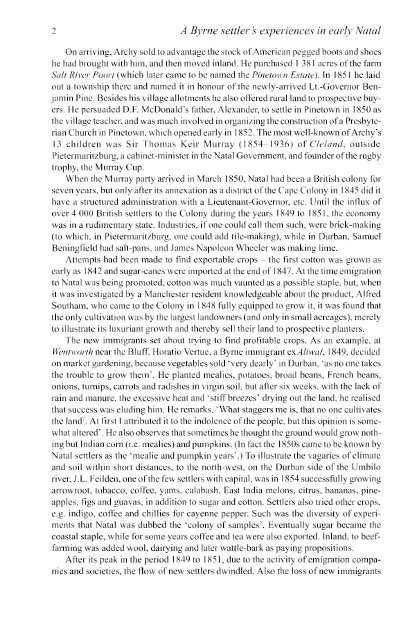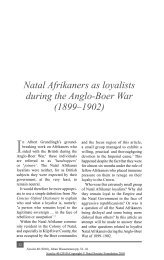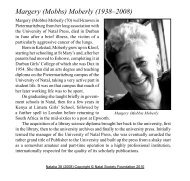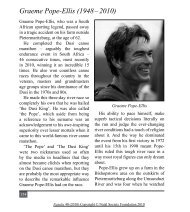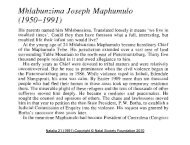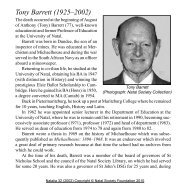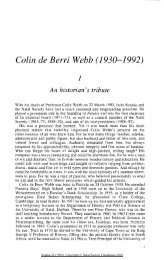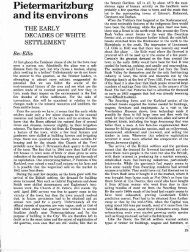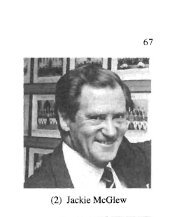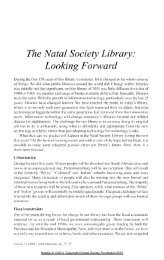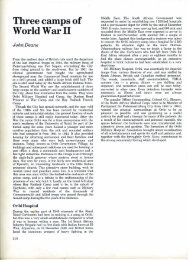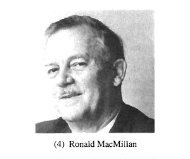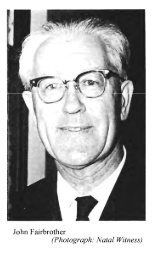A Byrne settler sexperiences in early Natal - Pmbhistory.co.za
A Byrne settler sexperiences in early Natal - Pmbhistory.co.za
A Byrne settler sexperiences in early Natal - Pmbhistory.co.za
Create successful ePaper yourself
Turn your PDF publications into a flip-book with our unique Google optimized e-Paper software.
2 A <strong>Byrne</strong> <strong>settler</strong> s experiences <strong>in</strong> <strong>early</strong> <strong>Natal</strong>On arriv<strong>in</strong>g, Archy sold to advantage the stock ofAmerican pegged boots and shoeshe had brought with him, and then moved <strong>in</strong>land. He purchased 1 3g I acres ofthe farmSalt River Poort (which later came to be named the P<strong>in</strong>eloH·'n Estate). In Ig51 he laidout a township therc and named it <strong>in</strong> honour of the newly-arrived Lt.-Governor Benjam<strong>in</strong>P<strong>in</strong>e. Besides his village allotments he also offered rural land to prospective buyers.He persuaded D.F. McDonald's father, Alexander, to settle <strong>in</strong> P<strong>in</strong>etown <strong>in</strong> IgSO asthe village teacher, and was much <strong>in</strong>volved <strong>in</strong> organiz<strong>in</strong>g the <strong>co</strong>nstruction ofa PresbyterianChurch <strong>in</strong> P<strong>in</strong>etown, which opened <strong>early</strong> <strong>in</strong> 1852. The most well-known ofArchy's) 3 children was Sir 'rhomas Keir Murray () 854-) 936) of Cleland, outsidePietennaritzburg, a cab<strong>in</strong>et-m<strong>in</strong>ister <strong>in</strong> the <strong>Natal</strong> Government, and founder ofthe rugbytrophy, the Murray Cup.When the Murray party arrived <strong>in</strong> \t1arch 1850, <strong>Natal</strong> had been a British <strong>co</strong>lony forseven years. but only after its annexation as a district of the Cape Colony <strong>in</strong> 1845 did ithave a structured adm<strong>in</strong>istration with a Lieutenant-Governor, etc. Until thc <strong>in</strong>l1ux ofover 4 000 British <strong>settler</strong>s to the Colony dur<strong>in</strong>g the years 1849 to 1851, the e<strong>co</strong>nomywas <strong>in</strong> a rudimentary state. Industries, if one <strong>co</strong>uld call them sllch, were brick-mak<strong>in</strong>g(to which, <strong>in</strong> Pietennaritzburg, one <strong>co</strong>uld add tile-mak<strong>in</strong>g), while <strong>in</strong> Durban, SamuelBen<strong>in</strong>gtield had salt-pans, and James Napoleon Wheeler was mak<strong>in</strong>g lime.Attempts had been made to t<strong>in</strong>d exportable crops the tirst <strong>co</strong>tton was grown as<strong>early</strong> as 1 g42 and sugar-canes were imported at the end of 1 g47. At the time emigrationto <strong>Natal</strong> was be<strong>in</strong>g promoted, <strong>co</strong>tton was much vaunted as a possible staple, but, whenit was <strong>in</strong>vestigated by a Manchester resident knowledgeable about the product, AlfredSoutham, who came to the Colony <strong>in</strong> 1 g4g fully equipped to grow it, it was found thatthe only cultivation was by the largest landowners (and only <strong>in</strong> small acreages), merelyto illustrate its luxuriant growth and thereby sell their land to prospective planters.The new immigrants set about try<strong>in</strong>g to f<strong>in</strong>d profitable crops. As an example, atWel7tvmrth near the Bluff, Horatio Vertue, a <strong>Byrne</strong> immigrant ex Ah'j,val, 1849, decidedon market garden<strong>in</strong>g, because vegetables sold 'very d<strong>early</strong>' <strong>in</strong> Durban, 'as no one takesthe trouble to grow them'. He planted mealies, potatoes, broad beans, French beans,onions, turnips, carrots and radishes <strong>in</strong> virg<strong>in</strong> soiL but after six weeks, with the lack ofra<strong>in</strong> and manure, the excessive heat and 'stiff breezes' dry<strong>in</strong>g out the land, he realisedthat success was elud<strong>in</strong>g him. He remarks, 'What me is, that no one cultivatesthe land 7 . At first I attributed it to the <strong>in</strong>dolence ofthe people, but this op<strong>in</strong>ion is somewhataltered'. He also observes that sometimes he thought the ground would grow nothbutIndian <strong>co</strong>rn (i.e. mealies) and pumpk<strong>in</strong>s. (In tact the 1850s came to be known by<strong>Natal</strong> <strong>settler</strong>s as the 'mealie and pumpk<strong>in</strong> years'.) To illustrate the vagaries of climateand soil with<strong>in</strong> short distances, to the north-west, on thc Durban side of the Umbiloriver, J.L. Feilden, one ofthe few <strong>settler</strong>s with capital, was <strong>in</strong> 1854 successfully grow<strong>in</strong>garrowroot, tobac<strong>co</strong>, <strong>co</strong>ffee, yams, calabash, East India melons, citrus, bananas, p<strong>in</strong>eapples,figs and guavas, <strong>in</strong> addition to sugar and <strong>co</strong>tton. Settlers also tried other crops,c.g. <strong>in</strong>digo, <strong>co</strong>tfee and chillies for cayenne pepper. Such was the diversity ofments that <strong>Natal</strong> was dubbed the '<strong>co</strong>lony of samples'. Eventually sugar became the<strong>co</strong>astal staple, while for some years <strong>co</strong>ffee and tea were also exported. Inland, to beeffann<strong>in</strong>gwas added wool, dairy<strong>in</strong>g and later wattle-bark as pay<strong>in</strong>g propositions.After its peak <strong>in</strong> the period 1849 to 1851, due to the activity ofemigration <strong>co</strong>mpaniesand societies, the flow of new <strong>settler</strong>s dw<strong>in</strong>dled. Also the loss ofnew immigrants


